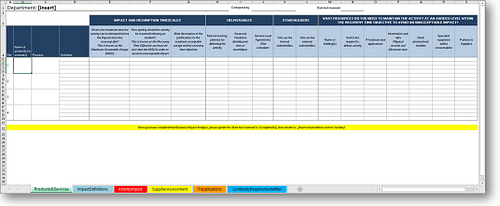–

Download the Business Impact Analysis template here.
Price: FREE Download
About this template
- A business impact analysis helps you better understand how you operate and is used to prioritize which parts of your business you want to protect.
- This template can help you identify the processes and activities that support your products and/or services;
- Understand the internal and external dependencies between your processes and activities;
- Determine the maximum time the processes and activities can be disrupted before you have an unacceptable impact;
- Identify the time following an incident within which each process and activity must be resumed (known as a recovery time objective).
- You can also use the template to identify the minimum resources (e.g. employees, buildings, IT, suppliers) your processes and activities need to resume within your recovery time objective.
–
What is in the business impact analysis template
The business impact analysis template is split into 6 sections:
- Products & Services. This is used to identify the products and services delivered by your departments and the processes and activities that support these. You can also consider dependencies, resource requirements and recovery timescales.
- Impact Definitions and Activity Impact. You can use this to help understand the impact over time if a process or activity was disrupted.
- Supplier Assessment. This helps you better understand how time critical your supply chain is so you can check your suppliers have appropriate business continuity solutions, where needed.
- IT Applications. This allows you to prioritize your applications for IT business continuity and disaster recovery planning.
- Continuity Resource Requirements. This is used to identify which resources you need over time to resume your processes and activities within the recovery time objective.
–
Other relevant templates available to download
–
Please find below a list of Frequently Asked Questions for the business impact analysis
What is a business impact analysis?
A business impact analysis is a process that analyzes the impact of a disruptive incident over time on an organization. This helps to determine the business continuity requirements for that organization and provides the information needed to identify appropriate business continuity solutions.
What is the purpose of a business impact analysis?
The purpose of the business impact analysis is to determine the business continuity requirements for the organization. Business continuity requirements include the time frames and resources necessary to continue the delivery of prioritized products, services, processes and activities following a disruptive incident.
What is the difference between a business impact analysis and a risk assessment
A business impact analysis is used to understand the impact over time a disruptive incident may have on products, services, processes and activities, and to determine the business continuity requirements. A risk assessment is used to assess the risk of prioritized products, services, processes and activities being disrupted so that appropriate measures can be put in place to reduce the likelihood and/or impact of a disruptive incident.
Why is a business impact analysis important?
A business impact analysis is important because it helps to prioritize products, services, processes and activities for business continuity planning and, following a disruptive incident, it also helps an organization to focus efforts on resuming the most time critical parts of the organization first. The business impact analysis is also used to identify dependencies, which is useful during a disruptive incident as it helps when thinking about which stakeholders need to be engaged.
What are the outcomes of conducting a business impact analysis?
After a business impact analysis has been completed, you will have an improved understanding of the processes and activities needed to deliver your products and services. This will help to either confirm the scope of the business continuity programme or can be used to justify amendments to the scope. Processes and activities will be prioritized by time based on the impact that is unacceptable to the organization and the time required to recover the process or activity. Legal, regulatory and contractual requirements may be clearer if this is included within the business impact analysis. The resource requirements for processes and activities will also be clearer and will help with identifying risk.
What are the main components of a business impact analysis?
The main components of a business impact analysis include criteria to help make sure business impact is consistently understood and scored across the organization. Identification of processes and/or activities that contribute to the delivery of your organization’s products and services. Identification of buildings, people, ICT systems and data, specialist equipment and/or consumables, partners and suppliers. Transport and logistics, and finance can also be included. Time frames for assessing impact over time to help determine the maximum acceptable outage and recovery time objective.
What is the first step of the business impact analysis process?
I would advise that the first step of the business impact analysis is to decide which type of business impact analysis you wish to do as there are different types. For example, the Business Continuity Institute Good Practice Guidelines break this down into an initial business impact analysis, a product and service business impact analysis, a process business impact analysis and an activity business impact analysis. You do not have to do all of these and you may decide to a combination of the above which is effectively what I have done with the business impact analysis template on my website. It partly depends on how much time and resource you have, and what the scope of your business continuity programme looks like. For more information, I recommend looking at the Business Continuity Institute’s Good Practice Guidelines as they are super helpful.
What are the steps in a business impact analysis?
The steps, or process and tasks, depend on which type of business impact analysis you decide to do. Once you know which type of business impact analysis you want to do, I recommend thinking about how that business impact analysis will then be delivered. That can be influenced depending on your time and resource, and the scope of your business continuity programme. You might choose to email the template and guidance to staff, schedule a workshop, develop a questionnaire that can be completed quickly, or meet with the staff needed to complete the business impact analysis. Then it’s a case of completing the business impact analysis, obtaining sign-off and reporting on the findings.
My experience
In the past, I’ve used a combination of emailing a business impact analysis template (such as the one on my website) along with a webinar explaining how to complete it and workshops. I’ve found some staff will complete the template fairly quickly and are fine to crack on with the webinar, others need more support and benefit from attending a workshop. Once the template has been completed though, then the owner obtains approval and sign-off, and I’ve recorded it in a governance spreadsheet so I can monitor when the next review is due. We’ve then moved onto the next step with the findings.
How do you do a business impact analysis?
There are many different ways to do a business impact analysis and the good thing about that is there’s a way that benefits everyone. It all depends on your appetite, time, resource and to some extent the culture of the organization. Budget can also influence which way you go. You might choose to email business continuity representatives a spreadsheet template with guidance or a webinar (similar to the one on The Continuity Advisor), hold a workshop, circulate a questionnaire, schedule meetings/interviews or hire a consultant to do it for you. If you want to know how to fill in the actual business impact analysis then you can find the relevant webinars in our Shop.
Which categories of business impact are valid?
Organizations can use many different categories for analyzing business impact and to some extent the type of industry you work in can influence this. Typically business impact categories might include welfare, finance, legal and regulatory, reputation, business objectives. You might also include operational, contractual, environmental or project. I wouldn’t say there’s a hard rule, it really depends on what is relevant for your business.
Supporting Information
PURPOSE
The purpose of a business impact analysis is to determine your business continuity requirements, recovery timescales and resource needs. This will then help you identify appropriate business continuity solutions for the processes and activities that support your products and/or services.
TOP TIPS
For SMEs, we recommend a business impact analysis is best completed through meetings. A business continuity professional will be able to complete the business impact analysis relatively quickly for you during a meeting as they will know the best questions to ask and the information that needs to be documented.
For more information on Business Continuity, we very much recommend looking at the Business Continuity Institute’s Good Practice Guidelines.
FACT
Creating a business continuity plan without completing the business impact analysis will lead to gaps in your planning. These gaps could create significant issues for you during an incident. For example, without a business impact analysis, the business continuity solutions may not resume the processes and activities within the necessary timescales to avoid an unacceptable impact.





